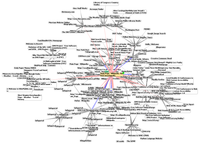
Photo from wikipedia
Coarse grain reconfigurable architectures (CGRAs) are an emerging hybrid computational architecture that has the parallel customization benefits of low-level logic devices, such as FPGAs and ASICs, while the relative coarseness… Click to show full abstract
Coarse grain reconfigurable architectures (CGRAs) are an emerging hybrid computational architecture that has the parallel customization benefits of low-level logic devices, such as FPGAs and ASICs, while the relative coarseness of these architectures makes CGRAs easier to design for, which is more similar to the traditional processor. In the process of mapping designs to CGRAs, flexible, fast, and adaptive placement and routing (P&R) is fundamental in order to implement efficient run-time reconfigurable frameworks. It is well-known that P&R is an NP-complete problem, and thus, solutions rely on heuristics to achieve quality results with acceptable execution times. CGRA P&R has different constraints compared to traditional VLSI P&R, e.g., path latency balancing and modulo scheduling of loops. In this work, we propose a graph-based P&R approach that uses graph traversals to map designs to CGRAs. Additionally, we parallelize our approach with a graph-based greedy heuristic that executes on a GPU. We compare our proposed P&R approach with the CGRA-ME framework, which implements simulated annealing and integer linear programming placement algorithms. Our results show that this new approach can generate optimal mappings and improve the execution run-time up to several orders of magnitude. Furthermore, considering spatial mapping at the millisecond scale, our GPU approach is one order of magnitude faster compared to the state-of-the-art tool VPR.
Journal Title: IEEE Transactions on Computer-Aided Design of Integrated Circuits and Systems
Year Published: 2021
Link to full text (if available)
Share on Social Media: Sign Up to like & get
recommendations!